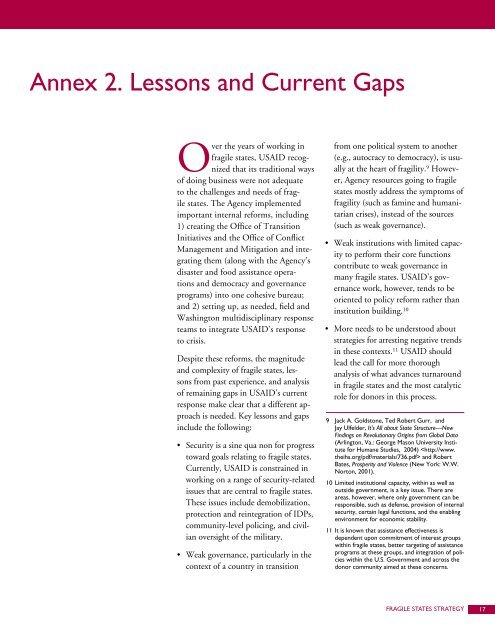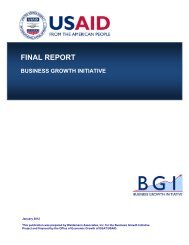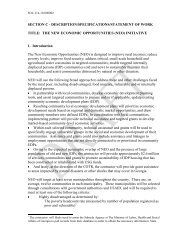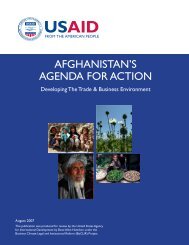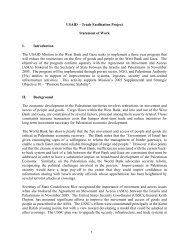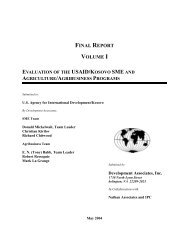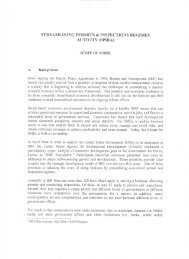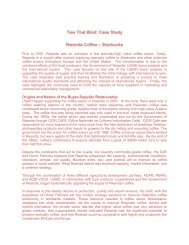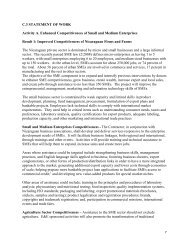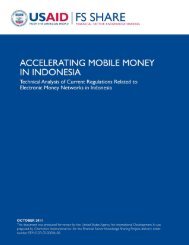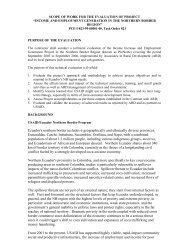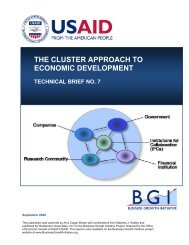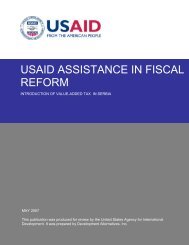USAID Fragile States Strategy - The Air University
USAID Fragile States Strategy - The Air University
USAID Fragile States Strategy - The Air University
- No tags were found...
Create successful ePaper yourself
Turn your PDF publications into a flip-book with our unique Google optimized e-Paper software.
Annex 2. Lessons and Current GapsOver the years of working infragile states, <strong>USAID</strong> recognizedthat its traditional waysof doing business were not adequateto the challenges and needs of fragilestates. <strong>The</strong> Agency implementedimportant internal reforms, including1) creating the Office of TransitionInitiatives and the Office of ConflictManagement and Mitigation and integratingthem (along with the Agency’sdisaster and food assistance operationsand democracy and governanceprograms) into one cohesive bureau;and 2) setting up, as needed, field andWashington multidisciplinary responseteams to integrate <strong>USAID</strong>’s responseto crisis.Despite these reforms, the magnitudeand complexity of fragile states, lessonsfrom past experience, and analysisof remaining gaps in <strong>USAID</strong>’s currentresponse make clear that a different approachis needed. Key lessons and gapsinclude the following:• Security is a sine qua non for progresstoward goals relating to fragile states.Currently, <strong>USAID</strong> is constrained inworking on a range of security-relatedissues that are central to fragile states.<strong>The</strong>se issues include demobilization,protection and reintegration of IDPs,community-level policing, and civilianoversight of the military.• Weak governance, particularly in thecontext of a country in transitionfrom one political system to another(e.g., autocracy to democracy), is usuallyat the heart of fragility. 9 However,Agency resources going to fragilestates mostly address the symptoms offragility (such as famine and humanitariancrises), instead of the sources(such as weak governance).• Weak institutions with limited capacityto perform their core functionscontribute to weak governance inmany fragile states. <strong>USAID</strong>’s governancework, however, tends to beoriented to policy reform rather thaninstitution building. 10• More needs to be understood aboutstrategies for arresting negative trendsin these contexts. 11 <strong>USAID</strong> shouldlead the call for more thoroughanalysis of what advances turnaroundin fragile states and the most catalyticrole for donors in this process.9 Jack A. Goldstone, Ted Robert Gurr, andJay Ulfelder, It’s All about State Structure—NewFindings on Revolutionary Origins from Global Data(Arlington, Va.: George Mason <strong>University</strong> Institutefor Humane Studies, 2004) and RobertBates, Prosperity and Violence (New York: W.W.Norton, 2001).10 Limited institutional capacity, within as well asoutside government, is a key issue. <strong>The</strong>re areareas, however, where only government can beresponsible, such as defense, provision of internalsecurity, certain legal functions, and the enablingenvironment for economic stability.11 It is known that assistance effectiveness isdependent upon commitment of interest groupswithin fragile states, better targeting of assistanceprograms at these groups, and integration of policieswithin the U.S. Government and across thedonor community aimed at these concerns.FRAGILE STATES STRATEGY 17


